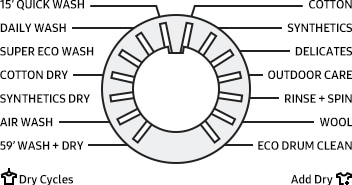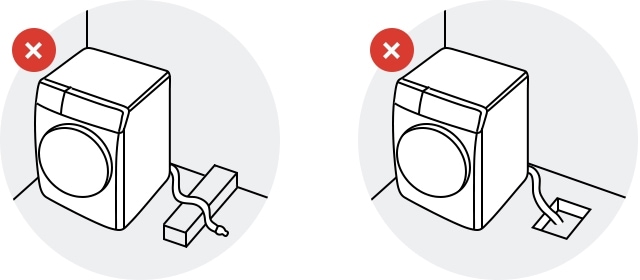What can I do when my clothes are damp even after the drying cycle has finished?
If the clothes are still damp after the drying cycle of the washing machine is finished, it is recommended to follow the important tips outlined below. You can check the amount and type of laundry and increase the drying time with the function to enhance the drying performance.
Quick solution for the damp clothes
Add additional time to the dry cycle
- If the time setting is shorter than the amount of laundry, increase the time of the dry cycle.
- All drying cycles can automatically detect the weight of the laundry for more effective drying.
- It is recommended to use automatic drying when the amount of laundry is less than 3 kg.
Change the drying course from ironing to strong
If the drying course is set to ironing, the performance is weak and, therefore, it is recommended to change the course to strong. For more effective drying for hand-washed laundry, it is recommended to select the dehydration and drying courses together.

Note:
- The actual design of the display panel may differ depending on the type of model you have.
- This image is a reference in English but is available in the language of your country.
Set the standard drying course
It is recommended that you always use a standard drying program. This program determines the recommended drying time based on the weight of the laundry.
Do not overload laundry
- It is always recommended to use a standard drying course, that weighs the laundry and uses it to determine the recommended drying time itself.
- If you put in a lot of laundry, it will not be evenly dried, and the spinning will be restricted resulting in having severe wrinkling of the fabric.
Do not mix different types of textiles
For more efficient drying, clothing must be separated by the type of textile. If you mix thick clothes and light fabric together, all light fabrics will be dried after the course is completed. Thick fabrics can be less dried. It is strongly recommended to classify similar fabrics when using the drying course.
If you need to dry just one or two pieces of clothes, add one or more of the same types of laundry. This improves the rotational capability and increases the drying efficiency.
- Thick Clothes: Towels, sweatshirts, vests, fleece clothing, etc.
- Thin Clothes: T-shirts, lingerie, activewear, socks, etc.
Please follow the recommended course according to the washing label
Check the washing label and select the appropriate drying course by pressing the button according to the fiber type. If you have thick clothing or a high quantity, choosing a strong drying course is more effective.
- Delicate course: Suitable for lingerie and thin clothes
- Wool course: Compliant with the specified capacity (1 kg), not fully dried to prevent damage to the clothes
- Towel course: Recommended to dry alone
- Jeans: Remove the pockets for even drying
- Shirt course: Use 3 or fewer shirts
Note: Courses may vary by model.
Check out the exterior options of the washing machine
Make sure the cold water faucet is opened
Drying requires the use of cool water. Therefore, if cold water is not supplied, it will not dry. Make sure that the cold water faucet valve is turned on.

Check the connection of the drain hose
Make sure that the drain hose is installed as a U-shaped trap device, or that the end of the drain hose is not submerged in water.
- Make sure that the drain hose at the back of the washing machine is connected properly and draining well.
- If you connect a drain hose longer than 3 meters, the draining efficiency can be low and may affect the drying function.

Note: Drying may not be possible in areas with low water pressure.
Is this content helpful?
Thank you for your feedback!
Please answer all questions.